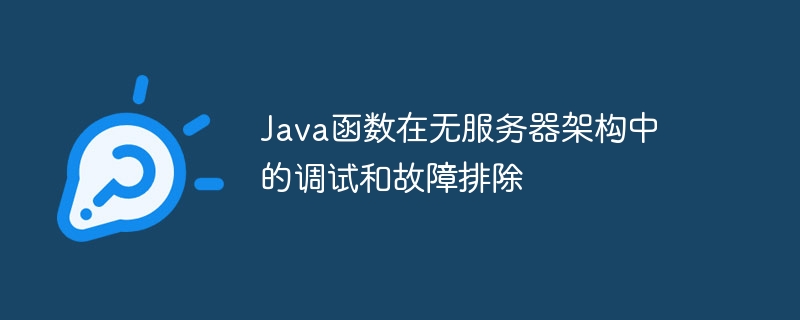Home >Java >javaTutorial >Debugging and troubleshooting Java functions in serverless architecture
Debugging and troubleshooting Java functions in serverless architecture
- WBOYWBOYWBOYWBOYWBOYWBOYWBOYWBOYWBOYWBOYWBOYWBOYWBOriginal
- 2024-04-27 09:54:02961browse
Debugging Java functions in a serverless architecture requires the use of logging, metrics, IDE debugging, and tools provided by the serverless platform. Logging and metrics are used to output error messages and provide performance insights. IDEs such as IntelliJ IDEA and Visual Studio Code support remote debugging, providing an interactive experience. Serverless platforms such as AWS Lambda and Azure Functions have built-in tools such as CloudWatch Logs, X-Ray, Application Insights, and Azure Monitor for tracing, error, and performance data.

Debugging and troubleshooting Java functions in a serverless architecture
Introduction
Serverless architecture manages by removing the infrastructure overhead, allowing developers to focus on writing code. However, debugging and troubleshooting serverless functions can be challenging because of the lack of visibility. This article explores techniques for debugging and troubleshooting Java functions in a serverless architecture.
Logging and Metrics
Logging and metrics are the cornerstone of serverless function debugging. Using a logging library like Logback or SLF4j will help output error messages or debugging information in the console. Metrics, such as application latency or error rates, can provide insights into function performance and health.
Debugging in Integrated Development Environments (IDEs)
Some IDEs, such as IntelliJ IDEA and Visual Studio Code, support remote debugging of serverless functions. After the function is deployed to the cloud platform, the IDE is able to connect to the function and set breakpoints and watch variables. This approach provides an interactive experience similar to traditional application debugging.
Use tools provided by serverless platforms
Serverless platforms such as Amazon AWS and Microsoft Azure provide built-in tools for debugging and troubleshooting functions. AWS Lambda offers CloudWatch Logs and X-Ray, while Azure Functions has Application Insights and Azure Monitor. These tools can provide traces of function execution, error messages, and performance data.
Practical Example: AWS Lambda Java Function
Consider a Java function using AWS Lambda that processes images from an S3 bucket. When the function fails, the console log shows the following error:
java.lang.NoClassDefFoundError: com.google.common.base.Preconditions
By remotely debugging the function and checking the classpath, it was discovered that the guava library is missing. Add the library manually with the following dependencies:
<dependency> <groupId>com.google.guava</groupId> <artifactId>guava</artifactId> <version>31.1-jre</version> </dependency>
After redeploying the function, the error disappears and the function runs normally.
Conclusion
It is possible to effectively debug and troubleshoot Java functions in a serverless architecture by leveraging a combination of logging, metrics, IDE debugging, and serverless platform tools. These techniques provide a comprehensive and practical way to pinpoint and resolve problems, ensuring function stability and performance.
The above is the detailed content of Debugging and troubleshooting Java functions in serverless architecture. For more information, please follow other related articles on the PHP Chinese website!

